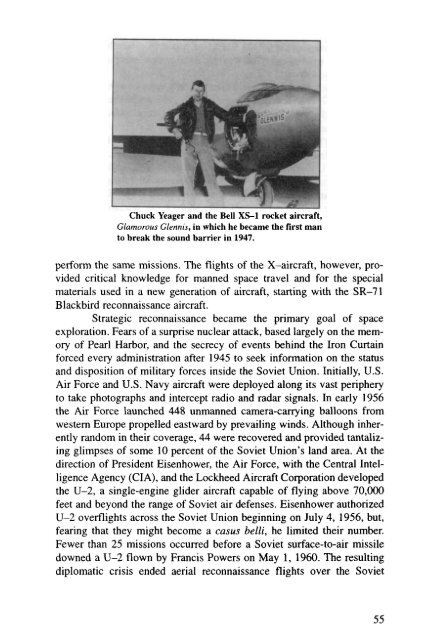A Concise History of the US Air Force - Air Force Historical Studies ...
A Concise History of the US Air Force - Air Force Historical Studies ...
A Concise History of the US Air Force - Air Force Historical Studies ...
Create successful ePaper yourself
Turn your PDF publications into a flip-book with our unique Google optimized e-Paper software.
Chuck Yeager and <strong>the</strong> Bell XS-1 rocket aircraft,<br />
Glamorous Glennis, in which he became <strong>the</strong> first man<br />
to break <strong>the</strong> sound barrier in 1947.<br />
perform <strong>the</strong> same missions. The flights <strong>of</strong> <strong>the</strong> X-aircraft, however, pro-<br />
vided critical knowledge for manned space travel and for <strong>the</strong> special<br />
materials used in a new generation <strong>of</strong> aircraft, starting with <strong>the</strong> SR-71<br />
Blackbird reconnaissance aircraft.<br />
Strategic reconnaissance became <strong>the</strong> primary goal <strong>of</strong> space<br />
exploration. Fears <strong>of</strong> a surprise nuclear attack, based largely on <strong>the</strong> mem-<br />
ory <strong>of</strong> Pearl Harbor, and <strong>the</strong> secrecy <strong>of</strong> events behind <strong>the</strong> Iron Curtain<br />
forced every administration after 1945 to seek information on <strong>the</strong> status<br />
and disposition <strong>of</strong> military forces inside <strong>the</strong> Soviet Union. Initially, U.S.<br />
<strong>Air</strong> <strong>Force</strong> and U.S. Navy aircraft were deployed along its vast periphery<br />
to take photographs and intercept radio and radar signals. In early 1956<br />
<strong>the</strong> <strong>Air</strong> <strong>Force</strong> launched 448 unmanned camera-carrying balloons from<br />
western Europe propelled eastward by prevailing winds. Although inher-<br />
ently random in <strong>the</strong>ir coverage, 44 were recovered and provided tantaliz-<br />
ing glimpses <strong>of</strong> some 10 percent <strong>of</strong> <strong>the</strong> Soviet Union’s land area. At <strong>the</strong><br />
direction <strong>of</strong> President Eisenhower, <strong>the</strong> <strong>Air</strong> <strong>Force</strong>, with <strong>the</strong> Central Intel-<br />
ligence Agency (CIA), and <strong>the</strong> Lockheed <strong>Air</strong>craft Corporation developed<br />
<strong>the</strong> U-2, a single-engine glider aircraft capable <strong>of</strong> flying above 70,000<br />
feet and beyond <strong>the</strong> range <strong>of</strong> Soviet air defenses. Eisenhower authorized<br />
U-2 overflights across <strong>the</strong> Soviet Union beginning on July 4, 1956, but,<br />
fearing that <strong>the</strong>y might become a cusus belli, he limited <strong>the</strong>ir number.<br />
Fewer than 25 missions occurred before a Soviet surface-to-air missile<br />
downed a U-2 flown by Francis Powers on May 1, 1960. The resulting<br />
diplomatic crisis ended aerial reconnaissance flights over <strong>the</strong> Soviet<br />
55
















